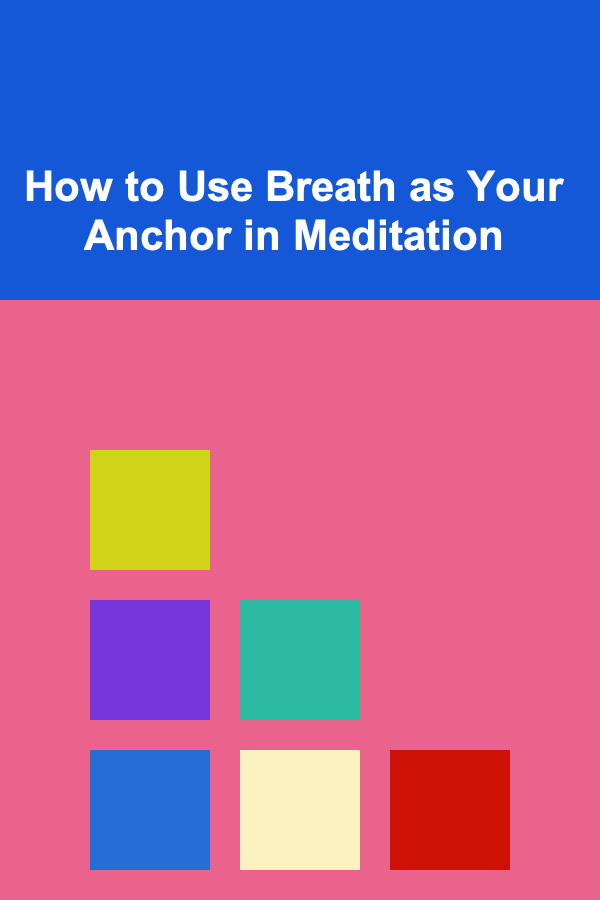
How to Use Breath as Your Anchor in Meditation
ebook include PDF & Audio bundle (Micro Guide)
$12.99$8.99
Limited Time Offer! Order within the next:

Meditation is a practice that has been embraced by people around the world for thousands of years, with countless traditions and techniques aiming to cultivate mindfulness, presence, and inner peace. Whether through breathing exercises, visualization, or mantra repetition, meditation serves as a means to still the mind and connect with the present moment. One of the simplest yet most profound methods of meditation involves using the breath as an anchor. This article explores the importance of the breath in meditation, why it works so effectively, and how to use it as a tool to deepen your practice.
The Power of Breath in Meditation
Breath is often referred to as the "anchor" in meditation for good reason. It's ever-present, always available, and vital to our survival. However, it is also something that is often taken for granted, and in the rush of modern life, many people lose touch with their breath altogether. When you bring attention to your breathing during meditation, it allows you to return to the present moment and disengage from distractions in the mind. This act of focused awareness on the breath can help foster a state of deep concentration and mindfulness.
Why the Breath?
There are several reasons why breath is such an effective anchor in meditation:
- Involuntary Nature: Breathing happens automatically, without any conscious thought. Yet, it can also be consciously controlled. This dual nature---simultaneously automatic and controllable---makes the breath a unique and powerful tool for anchoring the mind.
- Connection to the Body: The breath is a physical process, and paying attention to it brings the mind into direct connection with the body. This connection fosters a grounding effect, drawing attention away from mental distractions and into the present moment.
- Calming Effect: Deep, mindful breathing triggers the parasympathetic nervous system, which helps reduce stress and promote relaxation. By focusing on the breath, the body naturally shifts into a state of calmness.
- Accessible Anytime, Anywhere: No matter where you are, your breath is always with you. This makes it an ideal anchor for meditation, especially for beginners or those practicing in non-traditional environments.
- Simplicity: Using the breath as an anchor is simple and requires no external props or special techniques. This simplicity makes it accessible to everyone, regardless of experience level or meditation tradition.
The Mechanisms Behind the Breath as an Anchor
To understand how breath serves as a powerful tool in meditation, it's helpful to explore the mechanics of mindfulness and attention.
Mindfulness and the Breath
Mindfulness meditation focuses on cultivating a non-judgmental awareness of the present moment. This means observing whatever arises---whether thoughts, feelings, or sensations---without trying to control or judge them. The breath provides a stable point of reference that you can always return to whenever your attention wanders. By focusing on the breath, you can gently bring yourself back to the present moment without frustration or self-criticism. This process of returning to the breath repeatedly helps train the mind to stay present and avoid becoming lost in distractions.
Attention and Focus
The human mind is inherently distractible, often jumping from one thought to the next. However, when you focus your attention on the breath, you create a sense of continuity and stability. The breath, with its natural rhythm, becomes a reliable object of focus. When your attention inevitably drifts, you simply return to the sensation of breathing. Over time, this practice strengthens your ability to maintain focus, which can have positive effects not only in meditation but also in daily life.
Physiological Effects of Breathwork
In addition to its mental benefits, focusing on the breath can lead to physiological changes that enhance the meditation experience. Slow, deep breathing helps activate the parasympathetic nervous system (often referred to as the "rest and digest" system), which reduces the heart rate, lowers blood pressure, and induces relaxation. This physiological shift makes it easier to enter a meditative state, allowing the mind and body to sync in a way that promotes deep relaxation and mental clarity.
Types of Breath-Based Meditation Techniques
There are several specific meditation techniques that use the breath as the anchor. While the goal of each technique may vary slightly, they all rely on the breath to help guide the practitioner into a deeper state of mindfulness and presence. Here are some of the most commonly practiced breath-based meditation techniques:
1. Mindful Breathing Meditation
Mindful breathing is one of the most straightforward and accessible forms of breath meditation. In this practice, you focus your attention solely on the breath, noticing its natural rhythm and sensations. You might pay attention to the rise and fall of the chest or abdomen, the sound of the breath, or the feeling of the air passing through your nostrils. The goal is not to control the breath, but to observe it as it is.
- How to Practice :
- Sit comfortably in a quiet space.
- Close your eyes and bring your attention to your breath.
- Notice the sensation of the breath entering and leaving your body.
- If your mind wanders, gently return your focus to the breath without judgment.
2. Box Breathing
Box breathing, also known as square breathing, is a technique that involves inhaling, holding the breath, exhaling, and holding the breath again for equal counts. This technique is used to promote relaxation, reduce stress, and increase focus.
- How to Practice :
- Inhale for a count of 4.
- Hold your breath for a count of 4.
- Exhale for a count of 4.
- Hold your breath again for a count of 4.
- Repeat for several rounds, gradually increasing the duration as comfortable.
3. Alternate Nostril Breathing (Nadi Shodhana)
Alternate nostril breathing is a technique often used in yoga practices. It involves using the fingers to alternately block one nostril at a time while inhaling and exhaling through the other. This technique is said to balance the body's energy and calm the nervous system.
- How to Practice :
- Sit comfortably with your spine straight.
- Using your right thumb, block your right nostril.
- Inhale deeply and slowly through your left nostril.
- Close your left nostril with your right ring finger and release your right nostril.
- Exhale slowly and completely through the right nostril.
- Inhale through the right nostril, close it with your thumb, and exhale through the left nostril.
- Continue alternating nostrils for several rounds.
4. Breath Counting Meditation
In this technique, you count each breath to help maintain focus. As you inhale, count "one," as you exhale, count "two," and continue counting up to five or ten. If your mind wanders, start over from one. This method helps keep the mind engaged and prevents distraction.
- How to Practice :
- Sit in a comfortable position and take a few deep breaths.
- As you inhale, count "one," and as you exhale, count "two."
- Continue counting up to ten, then begin again at one.
- If you lose track or get distracted, start over from one without judgment.
5. Deep Breathing (Diaphragmatic Breathing)
Diaphragmatic breathing, also known as abdominal or belly breathing, involves taking deep breaths that expand the diaphragm rather than shallow breaths that only engage the chest. This type of breathing promotes relaxation and is often used to reduce stress and anxiety.
- How to Practice :
- Sit or lie down in a comfortable position.
- Place one hand on your abdomen and the other on your chest.
- Inhale deeply through your nose, allowing your belly to rise as you fill your lungs with air.
- Exhale slowly and completely through your mouth, allowing your belly to fall.
- Focus on the rise and fall of your abdomen with each breath.
How to Use the Breath as an Anchor: Step-by-Step
Now that we've explored the theoretical aspects of using breath as an anchor in meditation, let's go over a practical guide on how to incorporate breath awareness into your daily practice.
1. Find a Comfortable Space
To begin, find a quiet and comfortable space where you can sit undisturbed for the duration of your meditation. This could be a cozy corner in your home, a peaceful park, or even a quiet room at work. The key is to create an environment that encourages relaxation and stillness.
2. Sit Comfortably
Choose a sitting position that allows your body to remain relaxed yet alert. This could be sitting on a cushion, chair, or even lying down (though sitting is typically preferred to avoid falling asleep). Ensure that your spine is straight, your shoulders are relaxed, and your hands are resting comfortably on your lap or knees.
3. Close Your Eyes
Closing your eyes can help eliminate visual distractions, making it easier to turn your attention inward. If you prefer to keep your eyes open, try softening your gaze and looking down toward the floor.
4. Bring Attention to Your Breath
Start by taking a few deep breaths to center yourself. Inhale deeply through your nose, expanding your belly as you breathe in, and exhale slowly through your mouth, releasing any tension. Once you've settled, allow your breath to return to its natural rhythm.
5. Focus on the Sensation of Breathing
Direct your attention to the physical sensations of breathing. Notice the rise and fall of your chest or abdomen, the coolness of the air entering your nostrils, or the sound of your breath. Don't try to control the breath; simply observe it as it is.
6. Gently Redirect Your Attention
Inevitably, your mind will wander. When it does, gently bring your attention back to your breath. Don't judge yourself or get frustrated---just notice that your mind has wandered and return your focus to the anchor of your breath.
7. Deepen Your Awareness
As you continue to focus on the breath, you may notice subtle sensations or shifts in the body and mind. Deepen your awareness by exploring these sensations with curiosity and non-judgment.
8. End the Session Mindfully
When you're ready to end your meditation, slowly bring your attention back to the room around you. Wiggle your fingers and toes, stretch gently, and open your eyes. Take a moment to acknowledge the calm and clarity you've cultivated through your practice.
Conclusion
Using the breath as an anchor in meditation is a simple yet profound practice that can lead to greater mindfulness, clarity, and inner peace. By paying attention to the breath, we cultivate the ability to remain present and centered, even in the face of life's challenges. Whether you're a beginner or a seasoned meditator, the breath is always there to guide you back to the present moment, helping you navigate the ups and downs of life with a sense of calm and resilience.

How to Create a Tax-Efficient Financial Plan
Read More
How to Make the Transition to a Zero-Based Budget
Read More
How to Plan a Family Art Show to Display Your Creativity
Read More
How to Plan a Stress-Free Home Party from Start to Finish
Read More
How to Use Lighting to Create a Focal Point in Your Living Room
Read More
How to Build a Peaceful Morning Routine for Kids
Read MoreOther Products

How to Create a Tax-Efficient Financial Plan
Read More
How to Make the Transition to a Zero-Based Budget
Read More
How to Plan a Family Art Show to Display Your Creativity
Read More
How to Plan a Stress-Free Home Party from Start to Finish
Read More
How to Use Lighting to Create a Focal Point in Your Living Room
Read More